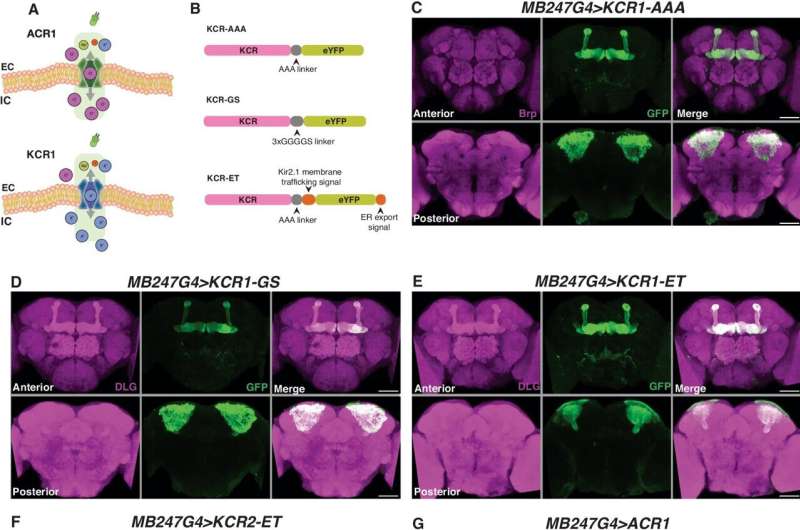This article has been reviewed according to Science X's editorial process and policies. Editors have highlighted the following attributes while ensuring the content's credibility:
fact-checked
peer-reviewed publication
trusted source
proofread
Researchers develop new light-controlled 'off switch' for brain cells

Researchers from Duke-NUS Medical School have found that a new class of light-sensitive proteins are capable of turning off brain cells with light, offering scientists an unprecedentedly effective tool to investigate brain function. The study, published in Nature Communications, opens exciting new opportunities to apply optogenetics to investigate the brain activity underlying neurodegenerative and psychiatric disorders such as Parkinson's disease and depression.
Optogenetics is a technique where specific cells are bioengineered to include light-sensitive proteins that act as switches, allowing researchers to precisely control the electrical activity of these cells. Neurons and nerve cells with optogenetic switches can be used to study how different cells participate in various brain circuits and behaviors.
The team showed that specific potassium channels, known as kalium channelrhodopsins, can serve as effective instruments for regulating brain-cell activity in three critical experimental animals: fish, worms, and flies.
Dr. Stanislav Ott, Senior Research Fellow with Duke-NUS' Neuroscience and Behavioral Disorders Program and first author of the study, said, "These potassium channels act like tiny gates on cell membranes. When exposed to light, these gates open and let potassium ions flow through, helping to quiet the activity in the brain cells. This offers us new insights into how brain activities are regulated."
Potassium ions are essential to normal electrical function in all human cells. Potassium channels are specialized proteins present in cell membranes that allow the flow of potassium ions. They regulate the flow of potassium ions across the cell membrane to maintain various cellular processes, and are critical to nerve-impulse transmission, muscle contraction, and cellular-fluid balance maintenance.
Associate Professor Adam Claridge-Chang from Duke-NUS' Neuroscience and Behavioral Disorders Program and the senior author of this study, said, "We've developed other remote-control switches previously, but we've found these potassium channels to be even more versatile, providing a very useful way to study how the brain works."
When triggered by light, the new kalium channelrhodopsins let potassium ions leave a neuron, changing the electrical gradient across the membrane. This change, known as hyperpolarization, makes it difficult for the neuron to generate the electrical signal known as an action potential. Without action potentials, a neuron's communication with other cells is greatly suppressed or even silenced.
The ability to silence brain cells using light-triggered potassium channels opens exciting avenues for studying the intricate interactions between different brain regions. It also offers a promising approach for exploring the pathological mechanisms underlying neurodegenerative, neurodevelopmental, and psychiatric disorders. These tools will help scientists form a deeper understanding of the brain and build paths to more effective treatments for brain disorders.
Professor Patrick Tan, Senior Vice-Dean for Research at Duke-NUS, said, "Unlocking the mysteries of the brain remains one of science's greatest challenges. Research like this by Adam Claridge-Chang and team equips scientists with better tools to study the intricate communication that goes on in the human brain and is essential to advancing our understanding of both healthy brains and neurological disorders, understanding that will enable us to develop effective new treatments for these conditions."
This study is part of Duke-NUS's ongoing efforts to advance understanding of neurological and psychiatric conditions.
More information: Stanislav Ott et al, Kalium channelrhodopsins effectively inhibit neurons, Nature Communications (2024). DOI: 10.1038/s41467-024-47203-w




















